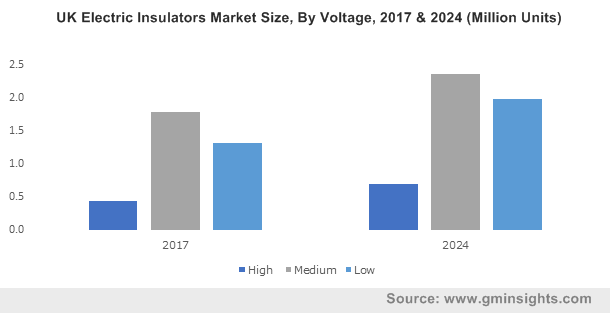Electric insulators market to witness phenomenal gains via proliferating grid extension projects, sustainability trends to outline the product landscape
Publisher : Fractovia | Published Date : 2018-07-23Request Sample
The concept of energy efficient power transfer has gained a renewed attention over the recent years. Electric insulators market, being an inherent vertical of power T&D business space, seems to be quite influenced by the similar trends. The confluence of environmental, economic, and geopolitical concerns circumventing around the reduction of disruptions in the power supply has placed the efficiency quotient at the forefront. As a result, a plethora of initiatives have been undertaken with the goal of improving the efficiency, which are apparently conspicuous from the increasing number of grid refurbishment activities across the globe.
UK Electric Insulators Market Size, By Voltage, 2017 & 2024 (Million Units)

While the success rate of the efforts taken has distinctively varied, it is undeniable that these encouraging initiatives toward extending the capacity and reliability of T&D networks has tremendously upscaled electric insulators industry demand. The declaration is aptly validated by electric insulators market assessment report, which claims that the overall business space has pegged a valuation of USD 4 billion in 2017.
Below mentioned are some of the significant grid extension projects that have left an impeccable impact on electric insulators market:
The European Union has recently allocated 9.9 million euros grant for the extension project of Georgian Transmission Network. Co-financed German government owned KfW Development bank and EBRD, the main goal of the program is to refurbish the grid infrastructure for the integration of hydropower plants, which would improve the energy supply of the Gregoria as well as cross bore trade. Transboundary projects such as these, involving hefty investments are bound to upscale the demand for grip equipment, which by extension would impel regional electric insulators market share.
The long-standing Hwange Power Generation extension project of USD 1.5 billion undertaken by Sino Hydro, that was apparently dealing with stumbling block since October 2014 with regards to financial closure, is finally onboard after the official confirmation by the Chinese Government. Sources claim that the regional government has had to make quite some trade & investment negotiations with the Zimbabwe government to proliferate the massive grid extension project of 600MW. The project is deemed to be a milestone for China electric insulators market growth, given the fact that the project is likely to deploy advanced power transmission components for its execution. As per estimates, China electric insulators industry size is forecast to record a CAGR of 5% over 2018-2024.
It is prudent to mention here that electric power and utility domain, of late, has been witnessing a paradox of sorts. Amidst a dynamically intense atmosphere, electric insulators market players are heavily backing on product innovations via R&D investments. In fact, groundbreaking innovations in distributed energy technologies are apparently challenging the conventional outlook of electric insulators industry pertaining to optimal utilization of grid infrastructure. A recent article published by ScienceNews on topological insulators can be placed as a testament to the aforementioned declaration.
As it is being reported, a new type of topological insulator has been inaugurated in electric insulators market, which is claimed to be more energy efficient and reliable than its conventional predecessor. While the underlining designing has been borrowed from the concept of traditional topological insulators, this advanced device is ingrained with grids of semiconductor rings that convert energy into light particles. Sources claim that the rings are clung together by race track shaped loops to channel all the photons along a single track around the grid until it results in emitting a light beam. Reportedly, while experimenting the researchers fed electrical energy into the grid’s outer ring, and it was found that the device could convert the energy into laser beam. Experts have been already raving about the breakthrough technology, claiming it be disruptive for the entire electric insulators industry space.
Another factor that has played its cards in bringing innovations in the marketplace is the surging demand for electricity at reduced costs but exceptional efficiency. The escalating supply demand gap has necessitated the requirement of product portfolio expansion for electric insulators market players. Major companies partaking in electric insulators industry have been heavily investing in renewable energy projects as a part of their social responsibility. Furthermore, supportive regulatory policies promoting energy efficient components integration in the power grid network would also open up new growth avenues for the entire business space. A market assessment report compiled by Global Market Insights, Inc. claims the overall electric insulators industry size to exceed USD 6 billion by 2024.